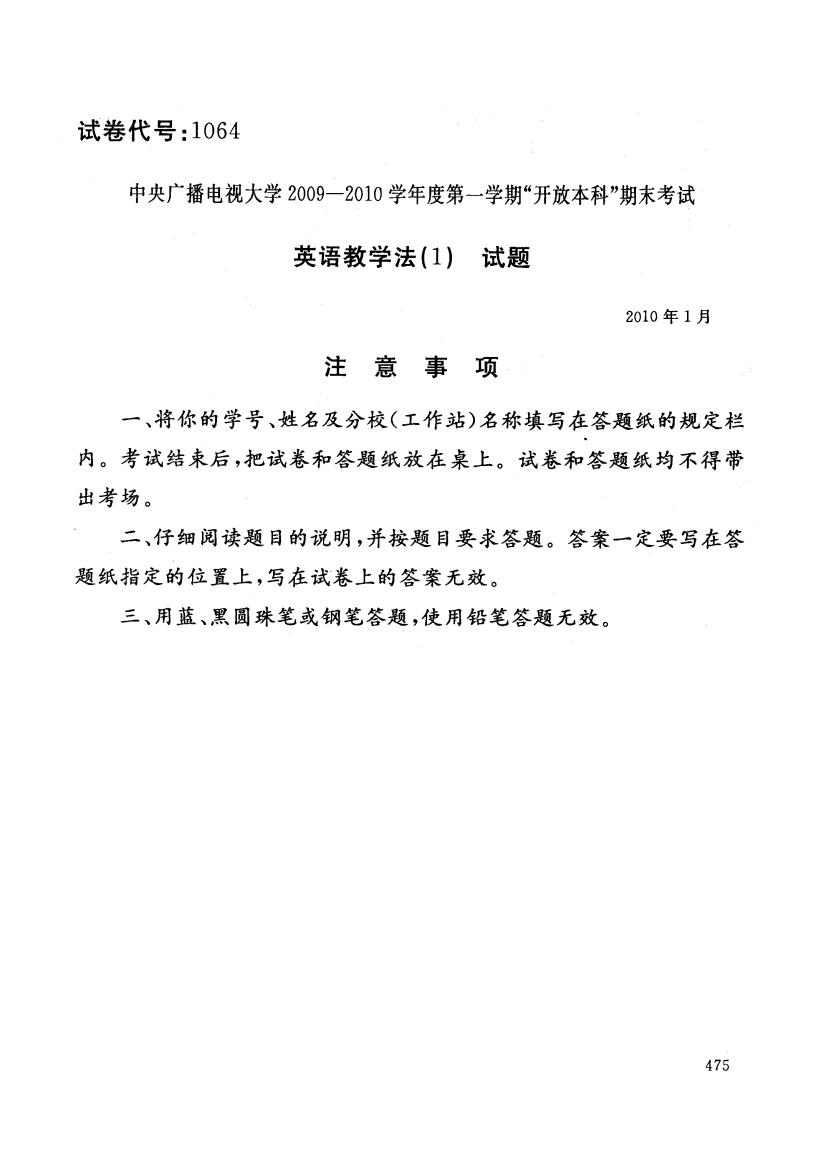
试卷代号:1064 中央广播电视大学2009一2010学年度第一学期“开放本科”期末考试 英语教学法(1)试题 2010年1月 注意事项 一、将你的学号、姓名及分校(工作站)名称填写在答题纸的规定栏 内。考试结束后,把试卷和答题纸放在桌上。试卷和答题纸均不得带 出考场。 二、仔细阅读题目的说明,并按题目要求答题。答案一定要写在答 题纸指定的位置上,写在试卷上的答案无效。 三、用蓝、黑圆珠笔或钢笔答题,使用铅笔答题无效。 475
试卷代号:1064 中央广播电视大学2009-2010学年度第一学期“开放本科”期末考试 英语教学法(1) 试题 2010年 1月 之闷卜 二己已 .侧怡. ,口口 j土 龙己 月巨 月以 一、将你的学号、姓名及分校(工作站)名称填写在答题纸的规定栏 内。考试结束后,把试卷和答题纸放在桌上。试卷和答题纸均不得带 出考场。 二、仔细阅读题 目的说明,并按题 目要求答题。答案一定要写在答 题纸指定的位置上,写在试卷上的答案无效。 三、用蓝、黑圆珠笔或钢笔答题,使用铅笔答题无效
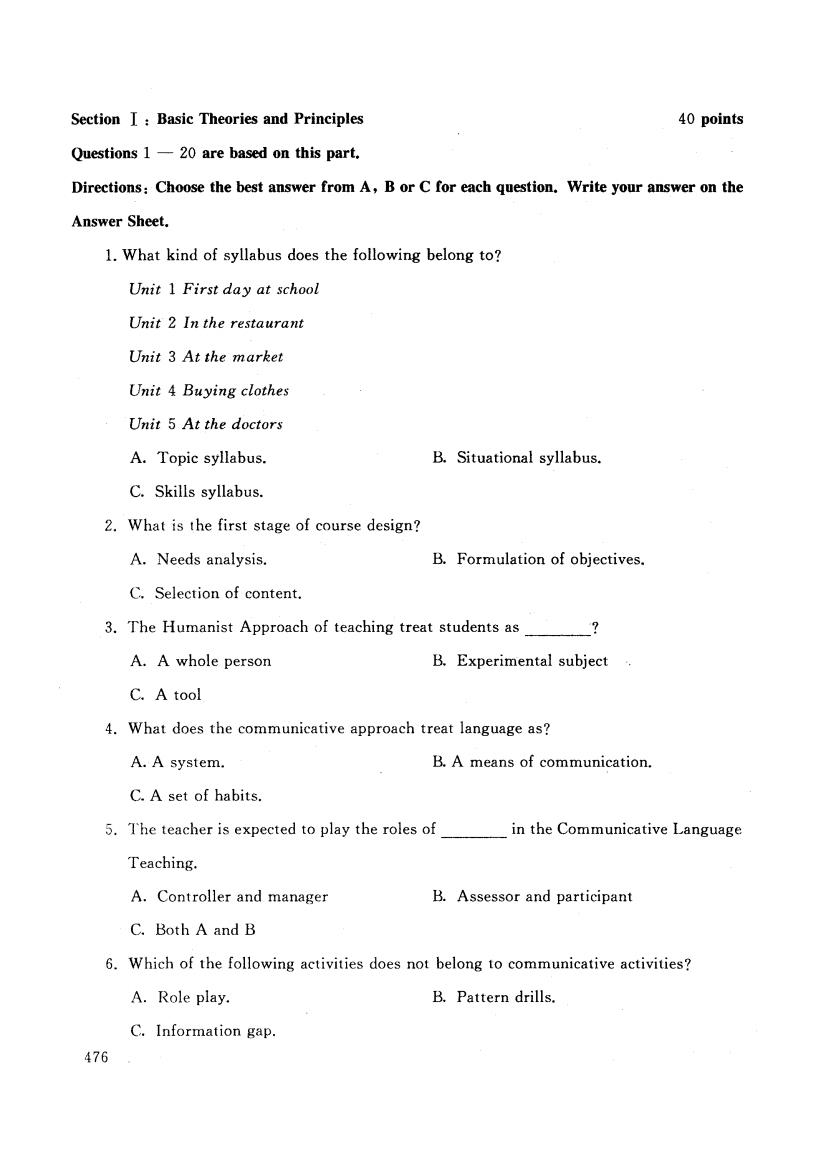
Section I:Basic Theories and Principles 40 points Questions 1-20 are based on this part. Directions:Choose the best answer from A,B or C for each question.Write your answer on the Answer Sheet. 1.What kind of syllabus does the following belong to? Unit 1 First day at school Unit 2 In the restaurant Unit 3 At the market Unit 4 Buying clothes Unit 5 At the doctors A.Topic syllabus. B.Situational syllabus. C.Skills syllabus. 2.What is the first stage of course design? A.Needs analysis. B.Formulation of objectives. C.Selection of content. 3.The Humanist Approach of teaching treat students as A.A whole person B.Experimental subject. C.A tool 4.What does the communicative approach treat language as? A.A system. B.A means of communication. C.A set of habits. 5.The teacher is expected to play the roles of in the Communicative Language Teaching. A.Controller and manager B.Assessor and participant C.Both A and B 6.Which of the following activities does not belong to communicative activities? A.Role play. B.Pattern drills. C.Information gap. 476
Section I:Basic Theories and Principles 40 points Questions 1一 20 are based on this part. Directions: Choose the best answer from A, B or C for each question. Write your answer on the Answer Sheet. 1. What kind of syllabus does the following belong to? Unit 1 First day at school Unit 2 In the restaurant Unit 3 At the market Unit 4 Buying clothes Unit 5 At the doctors A. Topic syllabus. B. Situational syllabus. C. Skills syllabus. 2. What is the first stage of course design? A. Needs analysis. B. Formulation of objectives. C. Selection of content. 3. The Humanist Approach of teaching treat students as_ ? A. A whole person B. Experimental subject C. A tool 4. What does the communicative approach treat language as? A. A system. B. A means of communication. C. A set of habits. 5. The teacher is expected to play the roles of_ in the Communicative Language Teaching. A. Controller and manager B. Assessor and participant C. Both A and B 6. Which of the following activities does not belong to communicative activities? A. Role play. B. Pattern drills. C. Information gap. 476

7.Which of the following does not belong to the Humanist Approach? A.Community Language Learning. B.Audio-Lingual Method. C.Suggestopedia. 8.Which of the following methods emphasizes dialogue memorization? A.Audio-Lingual Method. B.Grammar Translation Method. C.Natural Approach. 9.Teaching reading involves three stages:pre-reading,while-reading and A.Application B.Post-reading C.Practice 10.Which skill is "reading between the lines"involved in? A.Skimming. B.Scanning. C.Inferring. 11.What does "locating the specific information"help to train? A.Scanning. B.Skimming. C.Inferring. 12.What reading approach is based on the assumption of reading as a guessing game? A.The top-down approach. B.The bottom-up approach. C.The interactive approach. 13.Which of the following can be used to develop the skill of listening for gist? A.While listening,the students are required to look at a list of words and circle those used by the speaker. B.After listening,the students are required to write a summary of the text in a few sentences. C.After listening,the students are required to arrange the sentences in the order in which they are mentioned in the text. 477
7. Which of the following does not belong to the Humanist Approach? A. Community Language Learning. B. Audio-Lingual Method. C. Suggestopedia. 8. Which of the following methods emphasizes dialogue memorization? A. Audio-Lingual Method. B. Grammar Translation Method. C. Natural Approach. 9. Teaching reading involves three stages: pre-reading, while-reading and_ ? A. Application B. Post-reading C. Practice 10. Which skill is "reading between the lines" involved in? A. Skimming. B. Scanning. C. Inferring. 11. What does "locating the specific information" help to train? A. Scanning. B. Skimming. C. Inferring. 12. What reading approach is based on the assumption of reading as a guessing game? A. The top-down approach. C. The interactive approach. B. The bottom-up approach. 13. Which of the following can be used to develop the skill of listening for gist? A. While listening, the students are required to look at a list of words and circle those used by the speaker. B. After listening, the students are required to write a summary of the text in a few sentences. C. After listening, the students are required to arrange the sentences in the order in which they are mentioned in the text. 477
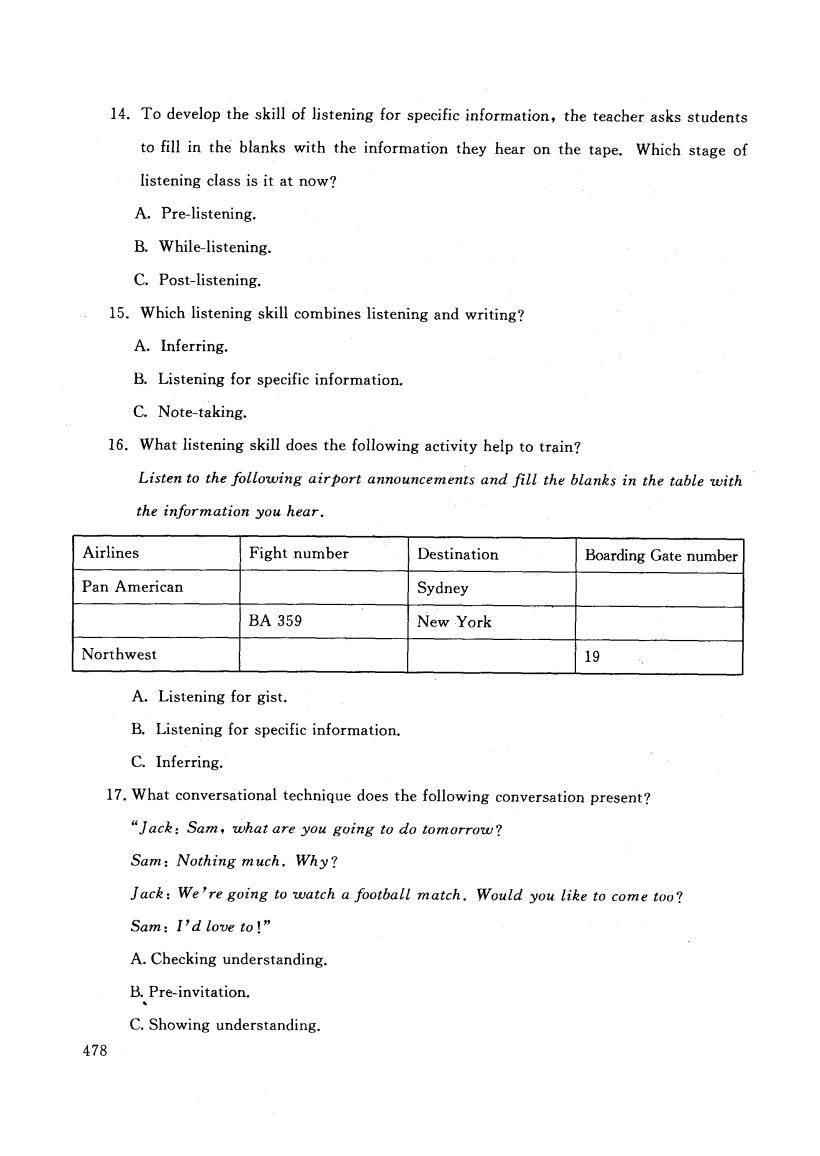
14.To develop the skill of listening for specific information,the teacher asks students to fill in the blanks with the information they hear on the tape.Which stage of listening class is it at now? A.Pre-listening. B.While-listening. C.Post-listening. 15.Which listening skill combines listening and writing? A.Inferring. B.Listening for specific information. C.Note-taking. 16.What listening skill does the following activity help to train? Listen to the following airport announcements and fill the blanks in the table with the information you hear. Airlines Fight number Destination Boarding Gate number Pan American Sydney BA359 New York Northwest 19 A.Listening for gist. B.Listening for specific information. C.Inferring. 17.What conversational technique does the following conversation present? “Jack:Sam,what are you going to do tomorrow? Sam:Nothing much.Why? Jack:We're going to watch a football match.Would you like to come too? Sam:I'd love to!” A.Checking understanding. B.Pre-invitation. C.Showing understanding. 478
14. To develop the skill of listening for specific information, the teacher asks students to fill in the blanks with the information they hear on the tape. Which stage of listening class is it at now? A. Pre-listening. B. While-listening. C. Post-listening. 15. Which listening skill combines listening and writing? A. Inferring. B. Listening for specific information. C. Note-taking. 16. What listening skill does the following activity help to train? Listen to the following airport announcements and fill the blanks in the table with the information you hear. Airlines Fight number Destination Boarding Gate number Pan American Sydney BA 359 New York Northwest 19 A. Listening for gist. B. Listening for specific information. C. Inferring. 17. What conversational technique does the following conversation present? "Jack:Sam, what are you going to do tomorrow? Sam:Nothing much. Why? Jack:We're going to watch a football match. Would you like to come too? Sam:I'd love to!” A. Checking understanding. B. Pre-invitation. C. Showing understanding. 478
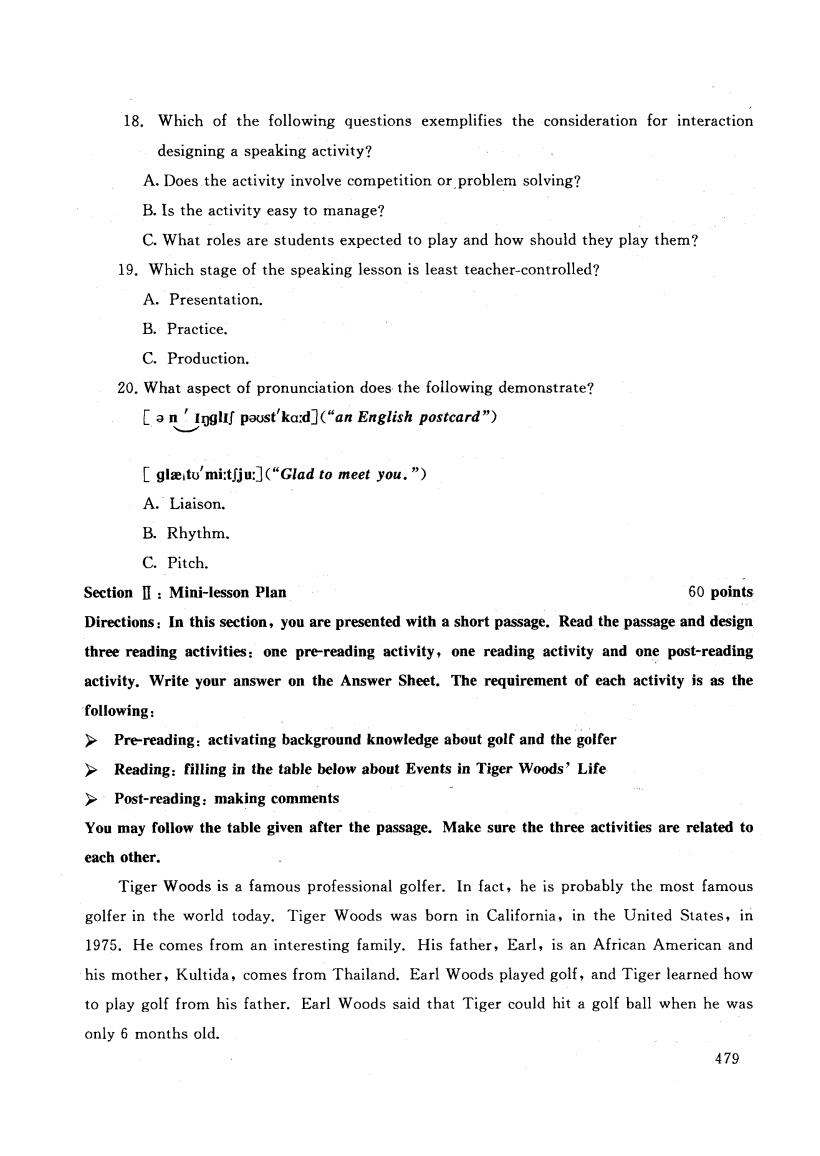
18.Which of the following questions exemplifies the consideration for interaction designing a speaking activity? A.Does the activity involve competition or problem solving? B.Is the activity easy to manage? C.What roles are students expected to play and how should they play them? 19.Which stage of the speaking lesson is least teacher-controlled? A.Presentation. B.Practice. C.Production. 20.What aspect of pronunciation does the following demonstrate? nIng paust'ka:d]("an English postcard") [glae,to'mitj:](“Glad to meet you.”) A.Liaison. B.Rhythm. C.Pitch. SectionⅡ:Min-lesson Plan 60 points Directions:In this section,you are presented with a short passage.Read the passage and design three reading activities:one pre-reading activity,one reading activity and one post-reading activity.Write your answer on the Answer Sheet.The requirement of each activity is as the following: >Pre-reading:activating background knowledge about golf and the golfer Reading:filling in the table below about Events in Tiger Woods'Life >Post-reading:making comments You may follow the table given after the passage.Make sure the three activities are related to each other. Tiger Woods is a famous professional golfer.In fact,he is probably the most famous golfer in the world today.Tiger Woods was born in California,in the United States,in 1975.He comes from an interesting family.His father,Earl,is an African American and his mother,Kultida,comes from Thailand.Earl Woods played golf,and Tiger learned how to play golf from his father.Earl Woods said that Tiger could hit a golf ball when he was only 6 months old. 479
18. Which of the following questions exemplifies the consideration for interaction designing a speaking activity? A. Does the activity involve competition or.problem solving? B. Is the activity easy to manage? C. What roles are students expected to play and how should they play them? 19. Which stage of the speaking lesson is least teacher-controlled? A. Presentation. B. Practice. C. Production. 20. What aspect of pronunciation does the following demonstrate? 〔,心 iUg1If paust'ka.d]("an English postcard") 〔glwituImi:tf ju:] ("Glad to meet you.”) A. Liaison. B. Rhythm. C. Pitch. Section I:Mini-lesson Plan 60 points Directions:In this section, you are presented with a short passage. Read the passage and design three reading activities; one pre-reading activity, one reading activity and one post-reading activity. Write your answer on the Answer Sheet. The requirement of each activity is as the following: 》 Pre-reading: activating background knowledge about golf and the golfer 》 Reading: filling in the table below about Events in Tiger Woods' Life 》 Post-reading; making comments You may follow the table given after the passage. Make sure the three activities are related to each other. Tiger Woods is a famous professional golfer. In fact, he is probably the most famous golfer in the world today. Tiger Woods was born in California, in the United States, in 1975. He comes from an interesting family. His father, Earl, is an African American and his mother, Kultida, comes from Thailand. Earl Woods played golf, and Tiger learned how to play golf from his father. Earl Woods said that Tiger could hit a golf ball when he was only 6 months old. 479
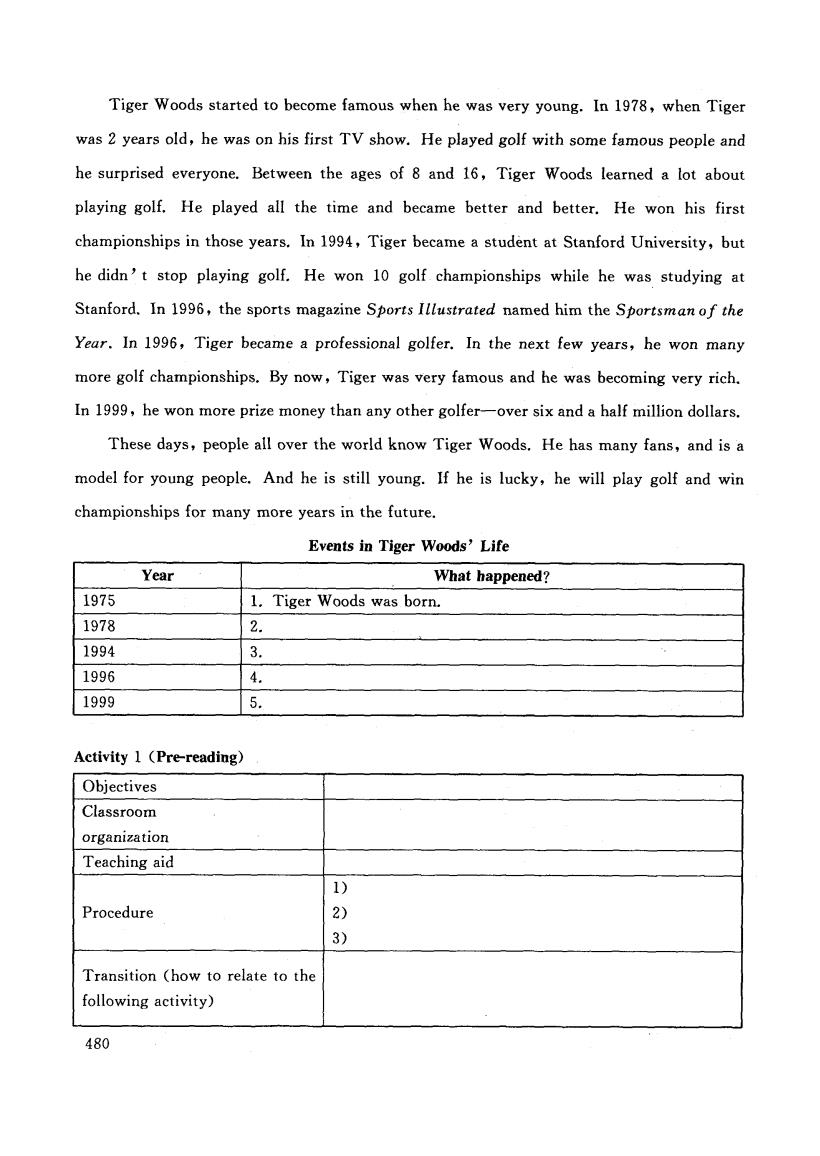
Tiger Woods started to become famous when he was very young.In 1978,when Tiger was 2 years old,he was on his first TV show.He played golf with some famous people and he surprised everyone.Between the ages of 8 and 16,Tiger Woods learned a lot about playing golf.He played all the time and became better and better.He won his first championships in those years.In 1994,Tiger became a student at Stanford University,but he didn't stop playing golf.He won 10 golf championships while he was studying at Stanford.In 1996,the sports magazine Sports Illustrated named him the Sportsman of the Year.In 1996,Tiger became a professional golfer.In the next few years,he won many more golf championships.By now,Tiger was very famous and he was becoming very rich. In 1999,he won more prize money than any other golfer-over six and a half million dollars. These days,people all over the world know Tiger Woods.He has many fans,and is a model for young people.And he is still young.If he is lucky,he will play golf and win championships for many more years in the future. Events in Tiger Woods'Life Year What happened? 1975 1.Tiger Woods was born. 1978 2. 1994 3. 1996 4. 1999 5. Activity 1 (Pre-reading) Objectives Classroom organization Teaching aid 1) Procedure 2) 3) Transition (how to relate to the following activity) 480
Tiger Woods started to become famous when he was very young. In 1978,when Tiger was 2 years old,he was on his first TV show. He played golf with some famous people and he surprised everyone. Between the ages of 8 and 16,Tiger Woods learned a lot about playing golf. He played all the time and became better and better. He won his first championships in those years. In 1994,Tiger became a student at Stanford University, but he didn’t stop playing golf. He won 10 golf championships while he was studying at Stanford. In 1996,the sports magazine Sports Illustrated named him the Sportsman o f the Year. In 1996,Tiger became a professional golfer. In the next few years, he won many more golf championships. By now,Tiger was very famous and he was becoming very rich. In 1999,he won more prize money than any other golfer-over six and a half million dollars. These days,people all over the world know Tiger Woods. He has many fans, and is a model for young people. And he is still young. If he is lucky, he will play golf and win championships for many more years in the future. Events in Tiger Woods' Life Year What happened? 1975 1. Tiger Woods was born. 1978 2. 1994 3. 1996 4. 1999 5. Activity I (Pre-reading) Objectives Classroom organization Teaching aid Procedure 1) 2) 3) Transition (how to relate to the following activity) 480
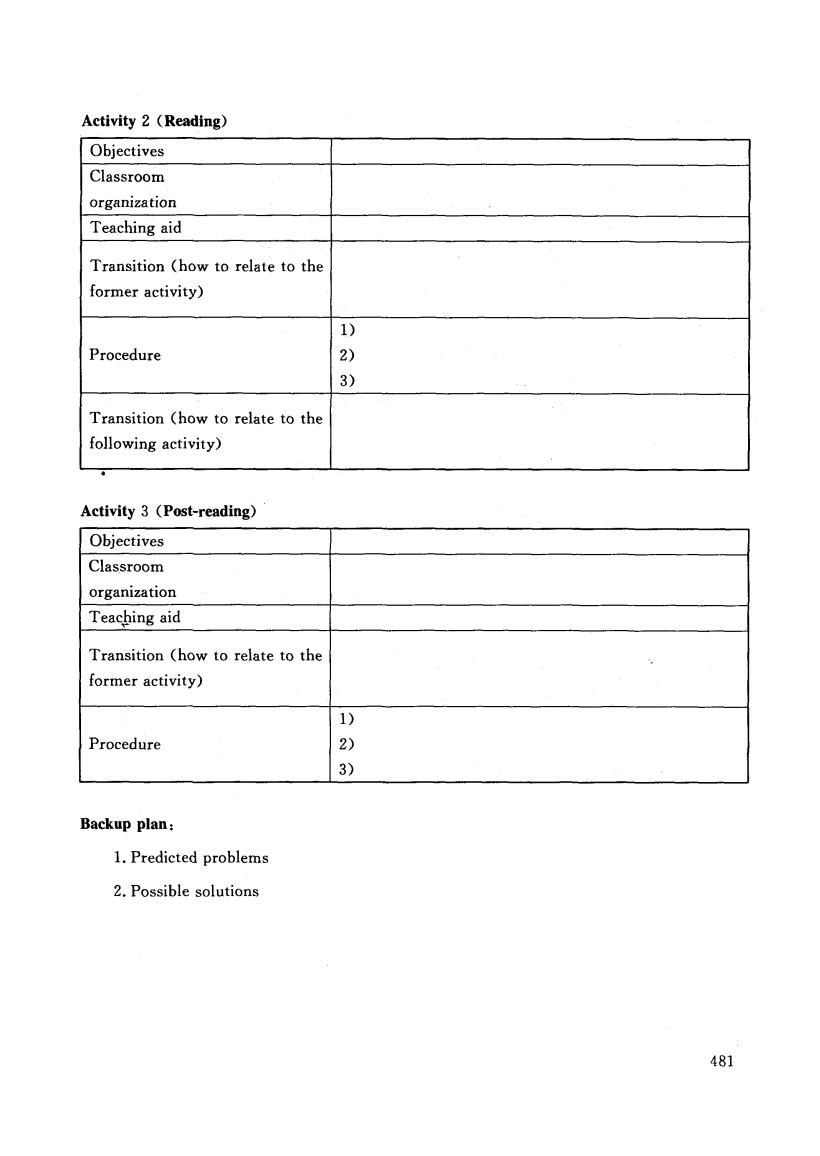
Activity 2 (Reading) Objectives Classroom organization Teaching aid Transition (how to relate to the former activity) 1) Procedure 2) 3) Transition (how to relate to the following activity) Activity 3 (Post-reading) Objectives Classroom organization Teaching aid Transition (how to relate to the former activity) 1) Procedure 2) 3) Backup plan: 1.Predicted problems 2.Possible solutions 481
Activity 2 (Reading) Objectives Classroom organization Teaching aid Transition (how to relate to the former activity) Procedure 1) 2) 3) Transition (how to relate to the following activity) Activity 3 (Post-reading) Objectives Classroom organization Tea中ing aid Transition (how to relate to the former activity) Procedure 1) 2) 3) Backup plan, 1. Predicted problems 2. Possible solutions 481
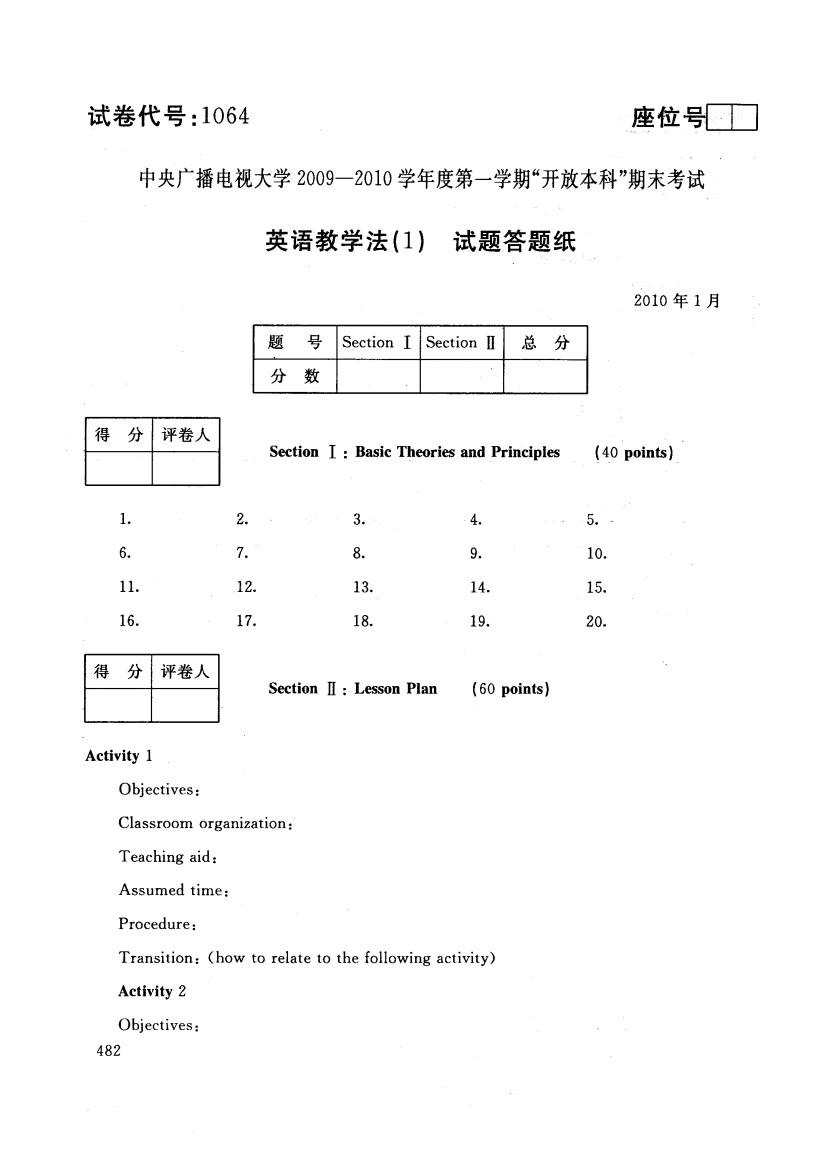
试卷代号:1064 座位号■ 中央广播电视大学2009一2010学年度第一学期“开放本科”期末考试 英语教学法(1)试题答题纸 2010年1月 题号 Section I Section II 总分 分数 得 分 评卷人 Section I:Basic Theories and Principles (40 points) 1. 2. 3. 4 5. 6. 7. 8. 9. 10. 11. 12. 13. 14. 15. 16. 17. 18. 19. 20. 得分 评卷人 SectionⅡ:Lesson Plan (60 points) Activity 1 Objectives: Classroom organization: Teaching aid: Assumed time: Procedure: Transition:(how to relate to the following activity) Activity 2 Objectives: 482
试卷代号:1064 座位号巨口 中央广播电视大学2009-2010学年度第一学期“开放本科”期末考试 英语教学法(1) 试题答题纸 2010年 1月 题 号 Section I Section I 总 分 分 数 得 分 评卷人 Section I:Basic Theories and Principles (40 points) . ︹U l.0 0 民 口 1 1 ,1 0 自 4. 9. 14 19 : , d ︵匕 nj O U I.~ 一.1 : 9 口 ~了 9 ︺ 门了 ,1 1 土 : ,.冬 冉七 一. 1 丹b j.l les 占 得 分 评卷人 Section II:Lesson Plan (60 points) Activity 1 Objectives: Classroom organization: Teaching aid: Assumed time: Procedure: Transition: (how to relate to the following activity) Activity 2 Objectives: 482

Classroom organization: Teaching aid: Assumed time: Transition:(how to relate to the former activity) Procedure: Transition:(how to relate to the following activity) Activity 3 Objectives: Classroom organization: Teaching aid: Assumed time: Transition:(how to relate to the former activity) Procedure: Backup plan: 1.Predicted problems 2.Possible solutions 483
Classroom organization: Teaching aid: Assumed time: Transition: (how to relate to the former activity) Procedure: Transition: (how to relate to the following activity) Activity 3 ’ Objectives, Classroom organization: Teaching aid: Assumed time: Transition: (how to relate to the former activity) Procedure: Backup plan: 1. Predicted problems 2. Possible solutions 483

试卷代号:1064 中央广播电视大学2009一2010学年度第一学期“开放本科”期末考试 英语教学法(1) 试题答案及评分标准 (供参考) 2010年1月 Section I Basic Theories and Principles 40 points 本题为单选题,共20个小题,总计40分,每题2分。 1.B 2.A 3.A 4.B 5.C 6.B 7.B 8.A 9.B 10.C 11.A 12.A 13.B 14.B 15.C 16.B 17.B 18.C 19.C 20.A SectionⅡ:Lesson Plan 60 points 参考答案和评分标准 Activity 1 (Pre-reading) Objectives:to activate students'background knowledge of Tiger Woods and golf. Classroom organization:Group work Teaching aid:pictures or videos Assumed time:5 minutes Procedure: 1.Lead-in:introduce the topic (1') The teacher presents several photos of Tiger Woods on the screen with PPT and asks the students who he is.Then ask the students what they know about him. 2.Group discussion (3') Arrange the students into groups of four to discuss what they know about him and which they like best about him. 3.Feedback (1') Invite each group of students to report their discussion. 484
试卷代号:1064 中央广播电视大学2009-2010学年度第一学期“开放本科”期末考试 英语教学法(1) 试题答案及评分标准 (供参考) 2010年 1月 Section I:Basic Theories and Principles 40 points 本题为单选题,共 20个小题,总计 40分,每题 2分。 1. B 2. A 3. A 4. B 5. C 6. B 7. B 8. A 9. B 10. C 11.A 12.A 13.B 14.B 15.C 16.B 17.B 18.C 19.C 20.A Section II:Lesson Plan 60 points 参考答案和评分标准 Activity 1 (Pre-reading) Objectives: to activate students' background knowledge of Tiger Woods and golf. Classroom organization: Group work Teaching aid: pictures or videos Assumed time: 5 minutes Procedure: 1. Lead-in: introduce the topic (1’) The teacher presents several photos of Tiger Woods on the screen with PPT and asks the students who he is. Then ask the students what they know about him. 2. Group discussion <3’) Arrange the students into groups of four to discuss what they know about him and which they like best about him. 3. Feedback(1’) Invite each group of students to report their discussion. 484